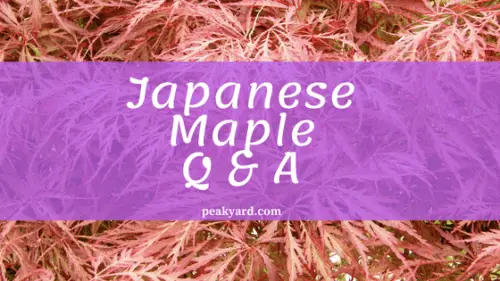Many people picture Japanese maple trees to have beautiful purple-red leaves with jagged ends. They may also envision a smaller sized tree with thin branches that is often found as an accent tree in landscaping.Yes, this is a common type of Japanese maple but there are actually an enormous variety that differ in leaf colors, leaf shapes, height, and other characteristics.
The uniqueness of Japanese maples often leave people with a lot of questions as they consider them as a tree for their yard. Below we have answered a few common questions that people ask about the Japanese maple.
-
Table of Contents
How big do Japanese maple trees grow?
Some can grow as tall as 30 feet or slightly more. There are also dwarf Japanese maples that only grow a couple of feet off the ground. The majority of the varieties fall somewhere in between.
-
Do Japanese maple trees lose their leaves?
One thing that all Japanese maples have in common is that they lose their leaves in the fall around November and then regrow new leaves in the spring. They are consider a deciduous tree because of this characteristic.
-
Do deer eat Japanese maple trees?
Just about every night one or two deer eat from my neighbors bird feeders about 30 yards away from my Japanese maple. They do venture into my yard based on the droppings found. After seven years, the deer have never touched my Japanese maple. However, this is not to say that they never will. While Japanese maples are often classified as deer resistant, many people have stated that their trees have been destroyed by deer. If given a buffet of food options, the Japanese maple likely would not be the ideal main course for a deer. However, if a Japanese maple is in the path of a deer, there is a chance it will eat it.
-
When is the best time to plant a Japanese maple?
Like grass seed, the best time to plant a Japanese maple is in the early fall. Fall is the season for new root growth making it the ideal time to plant. You want to allow enough time for the tree to take root before winter settles in.
-
Can Japanese maples grow in full sun?
Yes, Japanese maple trees can grow in full sun in most of the United States with proper watering. However, full sun can be a concern for southern growing zones (i.e central Florida and below or southern Texas). Ideally, you want your tree to have some shade to avoid leaf burn or scorch. Lakes Nursery provides a good list of Japanese maples you might consider for full sun.
-
Can Japanese maples grow in shade?
Generally, most Japanese maples can survive nicely in the shade. However, it is not recommended to plant them in heavy shade. Penn State recommends light to moderate shade for proper development.
-
What soil for Japanese maples?
The most important part of the soil is that it drains well. Too much water can ultimately kill your tree. The soil should not be drenched, but damp. Additionally, Japanese maples seem to fair the best in neutral to slightly acidic soil conditions. You may want to consider getting a soil test before planting to verify the soil is in the proper pH range.
-
Can Japanese maples grow in a pot?
Japanese maples are known for their ability to slowly grow in pots. The small or dwarf sized trees can remain in a pot, while the larger varieties will need to be transferred into your yard’s soil as they outgrow the pot. Pot or container planted Japanese maples give you the luxury of placing them wherever you like while also having the ability to move them.


